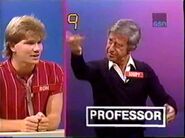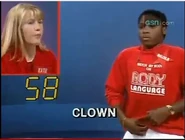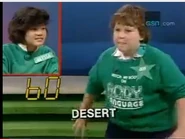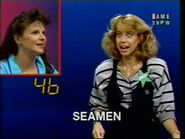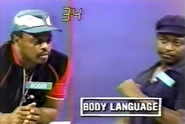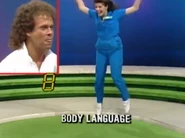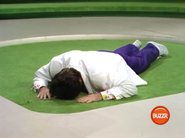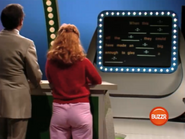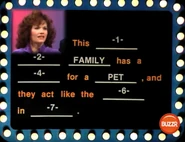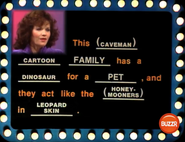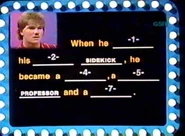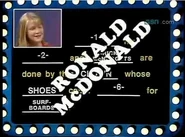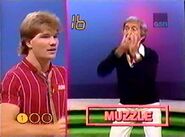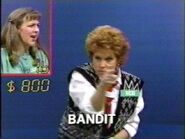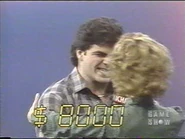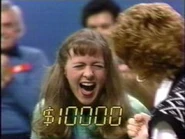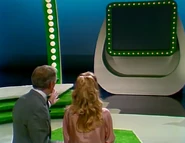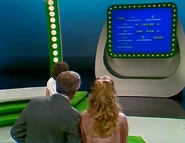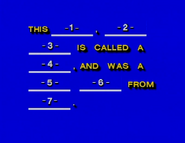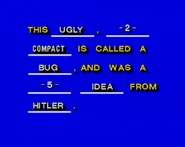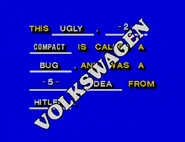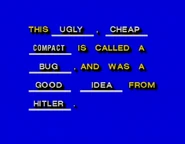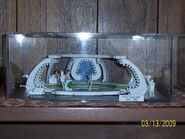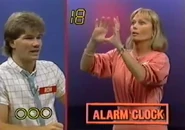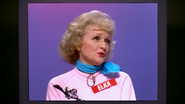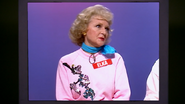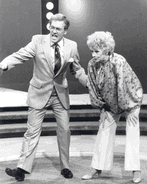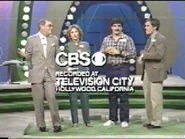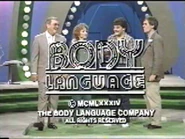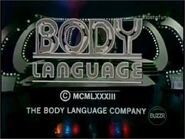| Host | |
| Tom Kennedy | |
| Announcers | |
| Johnny Olson (1983–1985) Bob Hilton (1985) Gene Wood (1985–1986) | |
| Broadcast | |
| Pilots: 10/9/1983 CBS Daytime: 6/4/1984 – 1/3/1986 | |
| Packager | |
| Mark Goodson Productions | |
Pilot Opening Spiel: "Let your body do the talking, onnnnnnn… Body Language! Let's meet the players: Jenilee Harrison, and her partner Anne-Marie Johnson! And for the men, Jon Bauman, and his partner Sam Houston! Now, here's the star of Body Language, Tom Kennedy!"
Series Opening Spiel: "It's a game for the uninhibited, and our stars this week (are): (celebrity #1), and (celebrity #2). Watch their bodies do the talking on… Body Language! And (now,) here's the star of Body Language, Tom Kennedy!"
Body Language was a short-lived game for the uninhibited, where Showoffs meets Password Plus/Super Password.
Gameplay[]
The show pitted two teams against each other, each consisting of a contestant and a celebrity guest. The gameplay centered around the party game charades, but contestants also had to solve word puzzles to win money.
Main Game[]
Teams played separately, with one player standing behind a podium, and the other in the acting area in front of it. Contestants had 60 seconds to guess as many of five words/phrases/names as they could. Actors could not talk, make sounds or use props, including clothing. They instead had to pantomime the words. They could pass on any words they wished and come back if time remained (a la Pyramid 2002, if a word was guessed after being passed, it wouldn't count until it was returned to and guessed then). Once time ran out or all five words or phrases had been guessed, the contestant was shown a puzzle. Should an actor violate any of the said rules above or even give away the word itself, the opposing contestant got first chance at the puzzle using the words said by the first player.
The puzzle was a sentence or question with seven numbered blanks. After over a month on the air and to avoid confusion, parentheses appeared around two missing words which indicated that those words were unacted. Whatever blanks whose acted words the contestant had managed to guess were then filled in, and the player won $100 if he/she could guess what the puzzle was describing. If not, the opponent was called over to choose a blank to reveal and then make a guess. The two contestants alternated revealing blanks and making guesses until one got the correct answer and won the puzzle. If neither one had solved it after all seven blanks were filled in, the celebrities were each given a guess. If they failed to solve the puzzle, the puzzle was thrown out and the value of that puzzle carried over to the next puzzle.
In the second round, the roles were reversed, and each puzzle was worth $250; starting in 1985 and continuing towards the end of the run, getting all five words awarded a cash bonus of $500 (bonus prize in case of teen contestants) which did not count towards the final score.
The first team to reach $500 won the game and advanced to the bonus round. If neither team reached $500 after the fourth puzzle, a $250 playoff puzzle will be played with no acting. The champion player have a choice of either to go first or have the challenger go first. Contestants again took turns revealing a chosen blank and guessing the puzzle until one guessed correctly, won the extra $250 and the game.
Bonus Round: Sweepstakes[]
The team had 60 seconds to guess as many of ten words and/or phrases as they could. Originally the winning celebrity gave the clues, but starting on June 10, 1985, the winning contestant will have the decision to make - that is whether to he/she wants to give or to receive (most celebrity decided to give). Like the main rounds, only the clue-giver could pass on a word, but could come back to it if time permitted, and like the main game, if words were guessed after being passed, they needed to be returned to and guessed again to count. Unlike the main game, illegal clues disqualified that word, and Tom went over the words missed after the time was up. Each correct word was worth $100. After the first half of the bonus round, the team played the second half in which three words had to be guessed in 20 seconds or less. If successful, the contestant's winnings were multiplied by ten, for a maximum of $10,000. If not, the contestant kept the money won in the first half. In this half, however, illegal clues would ended the round immediately.
Returning Champions[]
Originally, defending champs continue on and stay on the show until they either have one loss, have been in the sweepstakes five times or reached CBS's winnings limit of $25,000. In September 1984, this was modified so defending champs can stay on the show and continue playing our game until they either have two losses or have been in the sweepstakes six times. The winnings limit was later increased to $50,000 in October 22, 1984.
1983 Pilots[]
While the front game was the same, but with a different scoring structure ($100-$200-$300-$400) and the fact that the puzzle was revealed before the actor started acting, a different endgame was used, called "7 Chances". Two puzzles were shown one at a time, and the puzzles were the same as before but without the acting portion. The winning team picked off blanks by number and every word used being deducted from their seven (similar to the 1986 Chain Reaction endgame). The first puzzle was worth $500; solving both won $5,000 (on one pilot) or $7,000 (on another pilot) plus $1,000 per unused chance, a maximum of $10,000/$12,000.
In addition, all parts of the set were white & green. When the pilot became a series, some parts of the set (the scoreboard, the doors and the puzzleboard frame) were given a new paint job and changed color from green to blue.
Buzzr Version[]
From April 16 until June 11, 2015; a brief revival of the show was made for YouTube's Buzzr[1]channel hosted by Cynthia LuCiette featuring various internet celebrities as contestants.
Trivia[]
Before this show, their was a board game that was released by Milton Bradley also called Body Language with celebrity player Lucille Ball on the cover in 1975.
This was the second of three game shows that Tom Kennedy and Gene Wood worked on together; the first was Password Plus and the third and final was on the 1985-86 nighttime syndicated version of The Price Is Right.
This was the first of two game shows that Tom Kennedy and Johnny Olson worked on together; the other was the 1985-86 nighttime syndicated version of The Price Is Right, which Olson announced both of these shows until his death on October 12, 1985.
The original 1983 pilot aired on Buzzr as part of their "Lost and Found" week on September 11, 2015.
In the pilot, the win cue for "Seven Chances" was borrowed from Mindreaders (Dick Martin version) in 1979 and later used in pilots for Puzzlers in 1980 and Star Words in 1983.
The "disqualification" sound was the same as the "illegal clue" sound from Password Plus/Super Password.
Uniforms & Nametags[]
For the first two shows, all contestants & celebrities wore green nametags. Starting with the third show, championship teams wore red name tags while challenging teams continued wearing green name tags. Near the end of the run, celebrities' nametags were now star-shaped. On shows in which teenagers were contestants, players wore sweatshirts of their team color (green for the challengers & red for the champions).
Cancelled Merchandise[]
A board game version of Body Language was going to be released by Milton Bradley in 1985, but it did not get released at all.
Model Pic[]
In Popular Culture[]
In the 2000 documentary film Just Melvin, Just Evil by James Ronald Whitney about his grandfather named Melvin Just. A brief clip of James' appearance on Body Language from 1984 can be seen as he wins the Sweepstakes bonus round with his partner Abby Dalton.
ADDITIONAL NOTES:
He was under the name "Ron" according to his nametag.
According to the film, he was a "five day champion, retired undefeated".
Various clips of his appearance on Star Search from 1986 and 1987 can be briefly seen as well.
A brief clip from an episode of Body Language where Betty White appeared as a celebrity partner were included in the sixth episode of the third season of the hit TV Land sitcom Hot in Cleveland in 2012. However, the clip was digitally altered to have Betty's red nametag read as "Elka" to make it appear that White's character Elka Ostrovsky appeared on the show instead of "Betty". The episode in general was called "How Did You Guys Meet, Anyway?", originally airing on January 4, 2012.
Music[]
Pilot – "Working Girl March" by Dave Grusin (also used in pilots for Star Words in 1983 and On a Roll in 1986 and before that the film Tootsie in 1982)
Series – Score Productions
The ticket plug cue would be revamped and used on Classic Concentration; the ticket plug cue itself was also recycled into the 1985 pilot hosted by the late Orson Bean and said series as a prize cue.
Inventor[]
Robert Sherman
Studio[]
CBS Television City, Hollywood, CA
Rating[]
References[]
Gallery[]
Pictures[]
Tickets[]
Credits[]
Video Gallery[]
To see videos of Body Language, click here.
Tagline[]
"This is Johnny Olson/Bob Hilton/Gene Wood speaking for Body Language, a Mark Goodson Television Production."
(Said during series finale): "This is Gene Wood saying so long for Body Language, a Mark Goodson Television Production. This program has been edited for broadcast."
Links[]
Body Language (1983 Pilot) @ The Game Show Pilot Light website
Older Body Language page @ Game Show Utopia
Current Body Language page @ Game Show Utopia
Body Language @ tv-gameshows.com
Body Language @ Jay Anton


